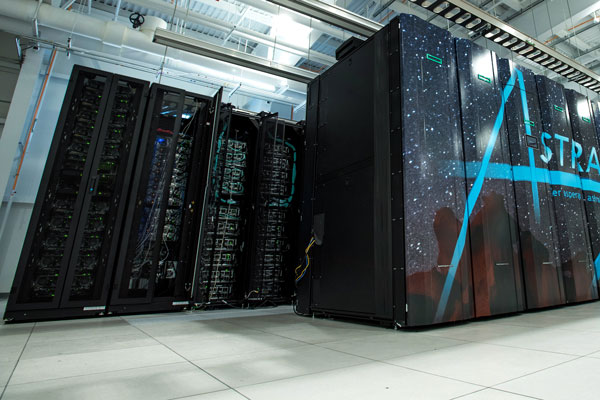Sandia to receive Fujitsu ‘green’ supercomputer processor

This spring, Labs researchers anticipate Sandia becoming one of the first DOE laboratories to receive the newest A64FX Fujitsu processor, a Japanese Arm-based processor optimized for high-performance computing.
Arm-based processors are used widely in small electronic devices like cell phones. More recently, Arm-based processors were installed in Sandia’s Astra supercomputer, where they are the frontline in a DOE effort to keep competitive the market of supercomputer chip providers.
“Being early adopters of this technology benefits all parties involved,” said Scott Collis, director of Sandia’s Center for Computing Research.
Penguin Computer Inc. will deliver the new system — the first Fujitsu PRIMEHPC FX700 with A64FX processors.
“This Fujitsu-Penguin computer offers the potential to improve algorithms that may not perform well on GPU (graphics processing unit) accelerators,” Scott said. “In these cases, code performance is often limited by memory speed, not the speed of computation. This system is the first that closely couples efficient and powerful Arm processors to really fast memory to help break down this memory-speed bottleneck.”
“Our goal is to provide early access to upcoming technologies,” said Ken Gudenrath, Penguin’s director of interactions with DOE.
Sandia will evaluate Fujitsu’s new processor and compiler using DOE mini- and proxy-applications and will share the results with Fujitsu and Penguin. Mini- and proxy-apps are small, manageable versions of applications used for initial testing and collaborations. They also are open source, which means they can be freely modified to fit particular problems.
“This acquisition furthers the Labs’ research and development in Arm-based computing technologies and builds upon the highly successful Astra platform, the world’s first petascale Arm-based supercomputer,” said James Laros, who leads Vanguard, Sandia’s advanced-architectures technology-prototype program tasked to explore emerging techniques in supercomputing.
Maximizing green computational power
The 48-core A64FX processor was designed for Japan’s soon-to-be-deployed Fugaku supercomputer, which incorporates high-bandwidth memory. It also is the first to fully utilize wide vector lanes that were designed around Arm’s Scalable Vector Extensions. These wide vector lanes make possible a type of data-level parallelism where a single instruction operates on multiple data elements arranged in parallel.
“The new processor’s efficiency and increased performance per watt provides researchers with significantly greater fractions of usable peak performance,” said Sandia manager Robert Hoekstra. “The Japanese supercomputing team at the RIKEN Center for Computational Science has partnered with Fujitsu and focused on increasing vectorization and memory bandwidth to maximize the computational power of the system. The result is that an early A64FX-based system sits atop the Green500 list of most efficient supercomputers.”
In addition to expanding Sandia’s efforts to develop new suppliers by advancing Arm-based technologies for high-performance computing, this acquisition also supports DOE’s collaboration with the Japanese supercomputing community.
Cooperation with the RIKEN Center is part of a Memorandum of Understanding signed in 2014 between DOE and the Japanese Ministry of Education, Culture, Sports, Science and Technology. Both organizations have agreed to work together to improve high-performance computing, including collaborative development of computing architectures.